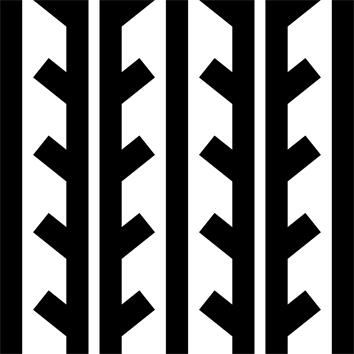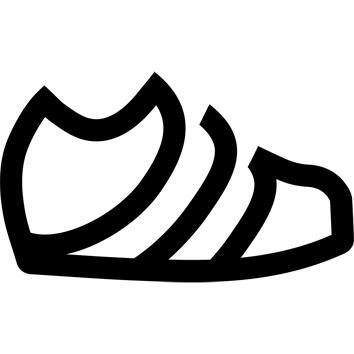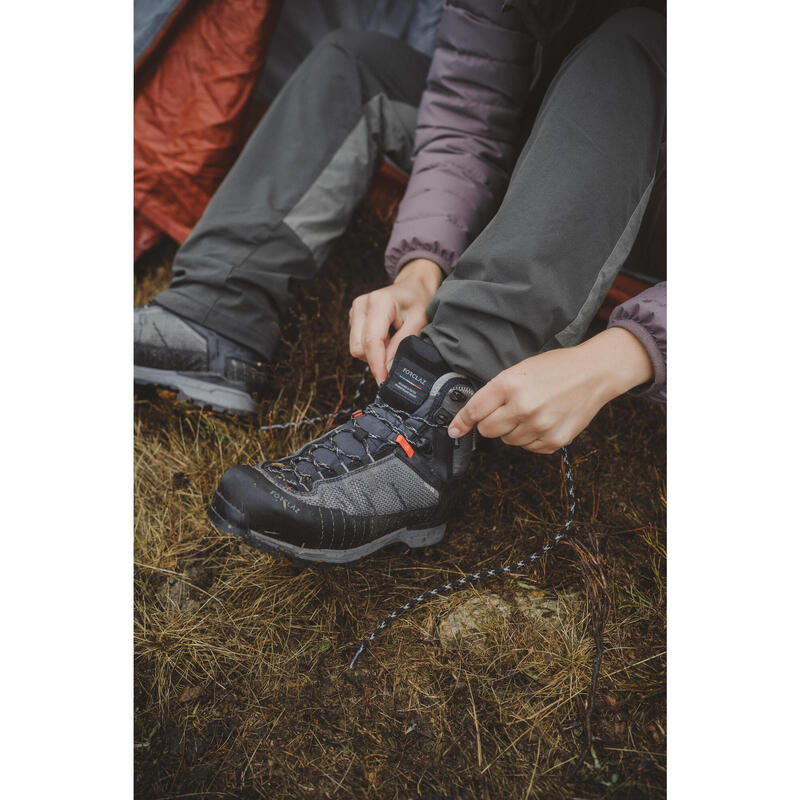Technical data
Lacing system Open hook + webbing
Blocking hook
Rubber front stone guard
Waterproof, breathable membrane
EVA midsole + soft PAD
PU heel insert
Outsole: Vibram® ForclazDesign with thick, deep lugs.
Composition lining: textile
Composition upper: high-strength textile Matryx®EVO
Weight:540g
Medium fit
Made in Europe
Advantages of the locking hook
Effectively dissociate the lacing of the lower and upper parts
This allows you to adjust the lacing to the shape of your foot and give your ankle more or less freedom. To lock this first tightening of the lower part, tie a simple knot at instep level, or use your shoe's blocker.
All our trekking shoes offer this option.
VIBRAM®. The grip and adherence of our soles
The grip of our soles is VIBRAM®-labeled, providing excellent grip on dry ground, dirt or rock.
In short, formidable! The VIBRAM® notching also gives you the grip you need on greasy, damp ground.
Medium-width sole: the wider the sole, the more flexible it tends to become.
So, with this sole, you can walk comfortably on most paths without losing stability.
MATRYX® EVO
MATRYX® EVO is a Jacquard fabric with an integrated lining. A technical composite of a PU 550dtex-coated PA warp and a PU 550dtex-coated PA weft.
A PES 167dtex lining.
Integration of aramid yarns throughout the upper to ensure good support and high abrasion resistance in the areas of the shoe most sensitive to friction.
The level of waterproofness of this shoe
This shoe has been waterproofed to 50,000 repeatable flexes, i.e. 20 km of walking in water up to mid-stem. This now guarantees a very good level of waterproofness for our shoes.
--> Our evaluation indicates a level of 4/5, which offers waterproofness for 8 hours of hiking in the rain.
Details of the tests carried out to evaluate the waterproofness of our shoes can be found a little further down.
Increase the waterproofness of your footwear with a gaiter
Waterproof footwear is often compromised by the ingress of water through the top of the shoe.
--> To keep feet dry for longer, we recommend the use of a waterproof gaiter or mini-gaiter to protect the top of the shoe from water ingress, as well as from stones and sand.
Model perfectly suited to this MT500 trekking gaiter in black.
Extend the waterproofing of this textile model
Even if this model has a membrane (waterproof-breathable), it's advisable to use a re-waterproofing spray a few times a year, to restore the original water repellency and combat external stains.
--> The aim is to restore the water repellency of the outer material (water beads up and doesn't seep through). Each textile part is then sprayed, taking care not to forget the sewing threads (water loves sewing threads!!).
Waterproofing my textile shoes with a water-repellent reactivator
1/ Use a brush and/or sponge to clean and remove dirt and mud residues.
2/ Leave to dry in the open air, away from a heat source.
3/ Shake the waterproofing spray can 5€
4/ Spray on the product from a distance of 25 cm
5/ Leave to work for at least 10 minutes.
Caution: Do not rub or wipe.
We recommend our water-repellent aerosol.
Main complementary laboratory tests
Laboratory tests are conducted to validate the following elements:
- hook and eyelet pull-out
- sole bonding
- toxicology
- UV resistance
- abrasion of sole and upper components
- accelerated ageing
Can only be used with strap crampons
This model of trekking boot allows the occasional use of strap-on crampons only. Its rigidity is sufficient for occasional use of strap crampons, while guaranteeing excellent walking comfort.
Choosing the right shoe size is a major challenge.
For hiking, don't hesitate to go one size larger than your usual shoe size, to ensure optimum comfort on the way down, and to prevent your toes from banging against the ground. Tip: keep your nails short and check that your lacing prevents your foot from slipping forward.
The waterproofing test carried out on this model
Our shoes are tested in the laboratory using 2 consecutive tests.
Test 1: We test the effectiveness of the membrane alone when immersed in water under air pressure. We simply check for the absence of bubbles at the surface, as with a punctured inner tube.
Test 2: Using a mechanical arm to simulate walking, the complete shoes are half immersed in water and flexed thousands of times to check that the inside of the shoe remains dry and therefore waterproof.
5 levels of waterproofing
In the waterproof test, we test 5 levels of waterproofness:
- 2,000 flexes (approx. 4 km, 30 min walk)
- 10,000 flexes (approx. 10 km, 3 hours walk)
- 30,000 flexes (approx. 15 km, 6 hours walk)
- 50,000 flexes (approx. 20 km, 8 hours walk)
- 100,000 flexes (approx. >20 km, 24 hours walk)
Try on your shoes step by step
To choose the right shoe:
1. Try on both shoes, standing, with the socks you use for hiking.
2. Tighten the laces correctly.
3. Check two important comfort points: the heel seat and the forefoot on descents.
4. Stand up to walk with your shoes on.
5. Try on several sizes and models.
6. Use your shoes gradually on the first few hikes to get them to fit your feet.
















